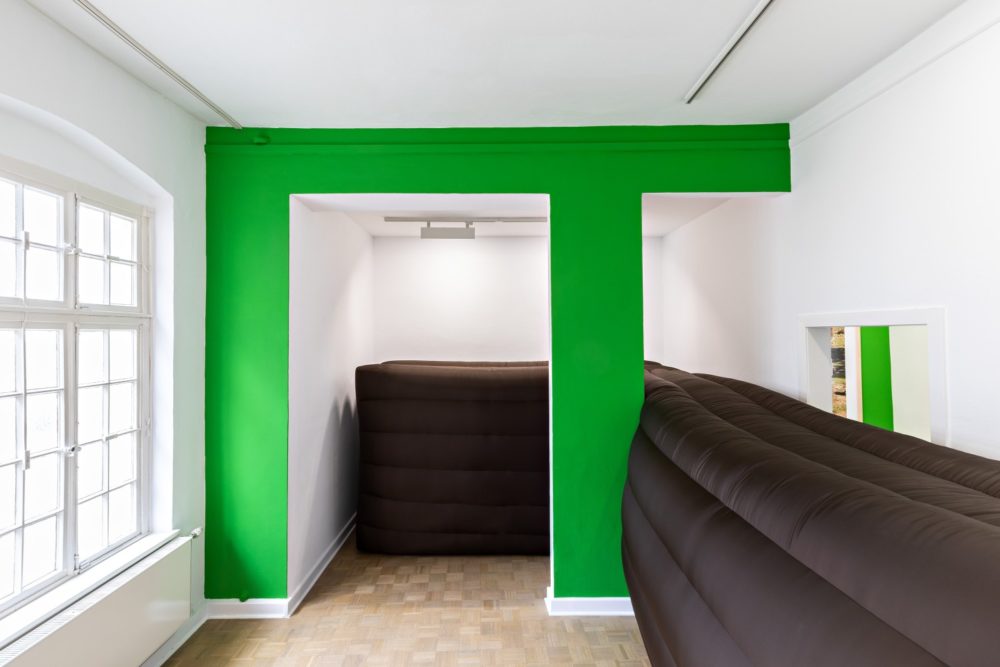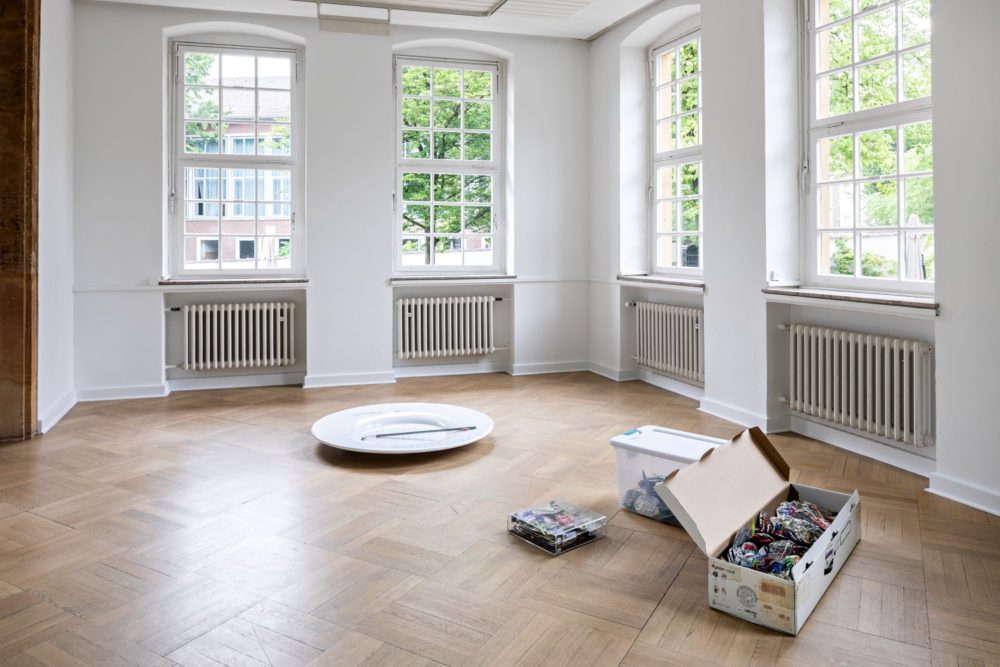
- Source: TEXTE ZUR KUNST
- Author: ELLEN WAGNER
- Date: OCTOBER 21, 2022
- Format: PRINT
Exhaustion and Permeability: SoiL Thornton at the Kunstverein Bielefeld By Ellen Wagner

SoiL Thornton, Decomposition Evaluation, Kunstverein Bielefeld, 2022. Installation view. All photos by Fred Dott.
Meaning is constantly being constituted and transformed. SoiL Thornton’s first institutional solo exhibition, Decomposition Evaluation, explores the ecological and economic conditions upon which this change occurs. At the heart of the exhibition is a reflection on emergence and decay—both on the physical-ecological level, looking at processes of composting and decomposition, and in the form of a preoccupation with the generation and decay of economic value. Art historian and author Ellen Wagner links the thematic strands of the exhibition and shows how Thornton’s works make it possible to experience the states between presence and absence, fullness and emptiness.
First, the eye falls on spacing. Moving through SoiL Thornton’s show, we encounter exhibits that rarely come together before our eyes to form complex, overlapping constellations. The status of the individual in an economic and ecological system is the thematic core of the exhibition Decomposition Evaluation. The spatial arrangement preludes this with a juxtaposition of large-scale and small-scale works, each of which seems clearly assigned its sphere of action. The objects nestle close to the wall and floor, inviting us to look at them individually up close. Nevertheless, the basic atmospheric tone is determined by a groping for connection: Individual series are distributed across several rooms and make contact with each other through color and formal correspondences.
Beginnings of dematerialized space/containment through exercising imagination, then exercising active practice? (ready to go) (2022) consists, according to artistic instruction, of exactly one wall in each exhibition space, painted bright chrome green. In video post-production, chroma colors, which do not occur in nature, facilitate automatic capture and fading in favor of newly added backgrounds. The evenly toned and illuminated surface dominates the still unedited image as a placeholder of future compositions. In the exhibition spaces, this background pushes forward, which can also be read metaphorically for an institutional or medial approach to artistic positions, persons, and above all their potentials.

SoiL Thornton, Decomposition Evaluation, Kunstverein Bielefeld, 2022. Installation view.
A potential can be exhausted or discarded, provided it is one’s “own.” But who can appropriate whom or what, and what value and benefit can be derived from it, is always under negotiation in a capitalist order. The fragility of these “ownerships” and the ambiguity of the “claims of use” of personalities and talents are points from which Thornton takes the presence of both artists in the market and discourse, and human bodies in general, to a tipping moment. Decomposition Evaluation takes a close look at the abdication and transfer of resources, space, and biomass. It raises questions about the sustainability of being present and in demand, of an appearance that always seems on the verge of being constructed or denied.
In the technically cool “reservedness” of the opaque monochrome, chrome-green walls, one could see a counterpart to the permeable process of composting, which becomes a theme in several works. Both signify an intermediate state: in the first case as a color signal that refers to the subject’s media performance and reveals itself as an instrument of an interchangeability of contexts; in the second case as lived matter situated in the collective organism between construction and deconstruction.

SoiL Thornton, Decomposition Evaluation, Kunstverein Bielefeld, 2022. Installation view.
Abruptly, Thornton has us encounter a passageway blocked by a giant L-shaped Inflatable, the Husband Chair (KB) (2022). Its soft surface in almost blackish brown makes the air vibrate gently. Behind it, inaccessible and only visible in a section, is the counterpart of a work that we see up close one floor above. Dirt photo (guarded) and Dirt photo (vulnerable) (both 2022) show prints from an analog photo of a cemetery view that could not be more mundane: lawn, wheelbarrow, excavated earth. Not much more. All this in coarse grain, which allows tangibility and fragility to fall into one: the imminent decay of a materially manifested memory and forgetting, whose “half-life” is not least socially conditioned.
The preconditions of social accessibility, particularly in relation to the spaces, institutions, and discourses of art, have long been central to Thornton’s artistic interests. Since graduating from Cooper Union in 2012, Thornton has reflected, both painterly and sculpturally, on the creation of value and meaning in an abstraction informed by everyday impressions and collage. New to this first institutional solo presentation in Europe is the theme of physical transience. This is addressed here not only as a positive quality of human vitality, but also in critical recognition of the fact that not all people are equally vulnerable, that even death still makes differences and brings social disparities to the fore. Both strands of content play around each other in the Bielefeld exhibition and form a fabric rich in associations.
For example, actualizing implications of self care through world care via capitals regenerative processes, i mean earths (2022) shows a certificate and material sample of a coffin interspersed with mycelia, which promises not to offer a final resting place, but to promote the dissolution of the body into the ecosystem and thus into new life. In relation to this, the assemblages on the floor in the show seem passive. Flattened and sucked out shells wrap themselves around empty containers; by means of surface imitation flexibilized, foiled all-purpose MDF was made into literal “presentation plates.” The work Who makes who at home (TZK edition) (2021), “served” on one of these objects, consists of a key to the editorial office of Texte zur Kunst, dipped in epoxy resin and thus rendered unusable, and the broken-out metal rod of a police barrier. The two are tied together in a meaningful way, as if they referred to something that transcends themselves, something that is difficult to put into words. While each element in itself embodies a limited access to a concrete public sphere, Thornton leaves it to our imagination how we link the two and with which critical school of thought, medium, or political spectrum we associate which inclusions and exclusions.
Assisted Cleansing/tactile gap glue (372 of 1,000,000) (2020–ongoing), in turn, presents run-over beverage cans, collected on the streets of New York and stashed in storage boxes. The straws, some of which are still present, hang out of their mouths like powerless tongues. Thornton has dented a total of 18 decorative trash cans in the form of shopping bags with physical effort for Waisted Breath (2022), “winged” them with wishes and then vacuum-packed them in plastic bags—the hopes preserved in product form.

SoiL Thornton, Assisted Cleansing/tactile gap glue (372 of 1,000,000), 2020.
Based on unspecific classical motifs of the world of goods, on boxes, bags, cans, these works initially seem anachronistic to the algorithmically personalized online shopping of the present. Their visual language touches on surrealist as well as pop art and post- internet aesthetics, so that when viewed, times collide and the relationship between expenditure and self-realization—as the production of a consumable, sometimes (apparently) also produced by consumption—becomes visible as an old and enduring problematic.
Through their emotionally charged treatment, the objects give the impression of proxy subjects. But where does the thought experiment of viewing people or artists analogously to readymades aidés lead to—to “recreated” (serial) industrial products full of invisible hopes? What does it imply to conceive of subjects as “readymade,” biographically shaped in one direction or another, usable entities or objets trouvés? And how do the assemblages allegorically interpreted here fit into a digital world—more corpses than zombies, refusing any display of activity? What background would one give them once the green screen fades out? Or does it rather depend on the underground, the breeding ground in the physical world?
The earth, soil and SoiL, is allowed to stand on its own in the show, as an invitation to participate: Visitors can leave kitchen waste on the compost in the Kunstverein’s courtyard, but not food that has already been processed. The work Pay it Forward (2022) thus makes decay visible as a living productive moment. Through its abundance, unfolded without much human intervention, it also lends meaning to the staged striking emptiness of the reworked readymades as their counterpart. A juxtaposition appears in the contrast of colors and materials: from garish chrome green, stoically recurring room after room, and warm dark tones, breathing as compost or as a sculptural body of air and a skin of silky textile.
Thornton manages to show the stages we love to play on, fulfill and reluctantly relinquish, as well as the bodies we are equally attached to, in both presence and absence. The appearance and departure, i.e. the moments shortly before and after a perceived, recognized “presence” move into the center as conditions for the construction and dismantling of structures that can be shaped. In their incipient and transformative forces, they are decisive for an economic and ecological understanding that is able to think beyond antagonistic functionality—and beyond “work” and “life,” perhaps enabling mutual visibility and tangibility.

